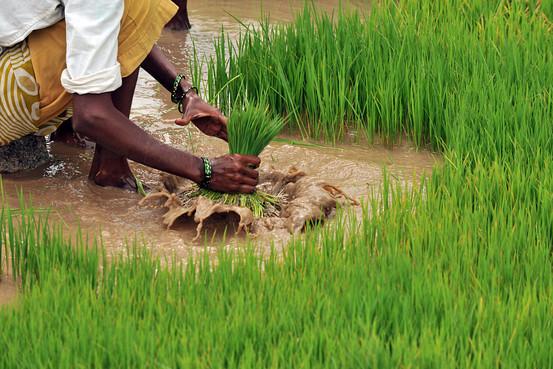India’s Foodgrain Economy

India's foodgrain economy which, after a period of decline following liberalisation, had shown some signs of a recovery, is once again on a declining trajectory. The recovery itself had been a limited one, taking per capita foodgrain output only to the level where it had roughly been before the onset of liberalisation, and from which it had slipped in the interim; but even that limited recovery has now been reversed.
If we calculate the per capita foodgrain output for 1990-91 (by taking the total gross foodgrain output in tones for the agriculture year 1990-91 and dividing it by the mid-year population figure for the calendar year 1991), then we get a figure of 207 kilogrammes. A similar exercise for the year 2011-12, which like 1990-91 was a good crop year, yields a figure of 212 kilogrammes. This certainly marked a recovery from the decline that had occurred in the interim, for the same calculation for 2003-04, which again was a good crop year, gives a per capita output of only 196 kilogrammes; but the recovery was a paltry one, barely crossing the level of per capita output that had been recorded in 1990-91. What is noteworthy however is that the per capita foodgrain output for every subsequent year after 2011-12 has been lower than for 2011-12 (not counting 2016-17 for which we do not yet have the data). The most generous interpretation one can put on these figures is that the per capita foodgrain output at the end of the liberalisation period is no higher than at the beginning (even if we do not make the stronger assertion, which it is possible to make, that it is actually lower).
But the level of foodgrain stocks with the government (we have no data on private stocks) in recent years has been far higher than before the period of liberalisation. For instance the level of year-end foodgrain stocks for the agricultural year 1990-91 was just 15.81 million tones which was about 9 percent of the foodgrain output of that year. But the level of stocks with the government at the end of 2011-12 exceeded 53 million tonnes which was more than 20 percent of that year’s output; and this is true of all recent years, namely that the level of stocks relative to output has been on average much higher than before liberalisation.
If the per capita output at the end of the liberalisation period is no higher than before liberalisation, and if the level of stocks relative to output is much higher, then it follows that per capita availability of foodgrains must have declined if we compare the end of the liberalisation period with its beginning. True, this conclusion will not hold if net imports of foodgrains are higher at the end of the liberalisation period than at the beginning; but in India the opposite has been the case. India has been a net exporter of foodgrains in every single year of the current century, with net exports being particularly high in some years (71 million tonnes in agricultural year 2013-14 according to the Economic Survey 2015-16, Table A 36). On the other hand, in the years before liberalisation there were hardly any foodgrain exports at all (while in some years of course there were net foodgrain imports).
It follows therefore that there has been a drop in net foodgrain availability if we compare the end of the period of liberalisation with its beginning. The figures for per capita net foodgrain availability per day in grams are given in Table 1 for certain individual years. To be sure, comparisons across particular years can be tricky, since there is a good deal of fluctuations in the annual figures and one may well be comparing a good crop year with a poor crop year; it is much sounder therefore to compare quinquennium or triennium averages; but the figures in Table 1 are quite robust, and even if we took such averages it would make no difference to the conclusion.
Table 1: Per Capita Daily Availability of Foodgrains (Grams)
1951: 394.9 2001: 416.2
1961; 468.7 2011: 453.6
1971: 468.8 2012: 450.3
1981: 454.8 3013: 401.4
1991: 510.1 2014: 491.2
Source: Government of India, Economic Survey 2015-16.
It is clear from the Table that even the uncharacteristically high figure for 2014, when averaged with the figures of the two previous years, gives a level of availability that is lower than at the beginning of the decades of the sixties, seventies, eighties and the nineties. In other words the phenomenon of a decline in per capita foodgrain availability is clearly established. While per capita availability is different from per capita consumption (since private stock variations are not taken into account in calculating availability), a decline in per capita availability in the present case is clearly associated with a decline in per capita consumption (for which we have independent confirmation anyway from NSS data on calorie intake).
When confronted with such evidence, defenders of liberalisation and all those who derive satisfaction from figures of GDP growth, tend to argue that a reduction in per capita foodgrain consumption is symptomatic of a change in consumption pattern towards more sophisticated goods, which typically occurs when people become better off. In other words, a decline in per capita availability of foodgrains, far from indicating a worsening in the living condition of the people, shows on the contrary that people are actually becoming better off, and diversifying their consumption towards more sophisticated goods.
This however is a completely erroneous argument. While it is true that the direct intake of foodgrains per capita may fall as people become better off, their total per capita intake of foodgrains, both directly and indirectly in the form of processed food and of animal products (into which foodgrains enter as feedgrains), increases with an increase in real income. The total per capita ingestion of foodgrains in the US for instance is almost five times that in India and in Europe almost four times. Even within India cross-section data show that per capita total ingestion of foodgrains increases as incomes rise, with the rich consuming more foodgrains directly and indirectly compared to the poor. Now, the figures given above refer not to direct absorption of foodgrains alone, but to total absorption, both direct and indirect. And if they show a decline over time with the introduction of neo-liberal economic policies then that must signify an adverse development.
The phenomenon of larger foodgrain stocks and larger exports, even when per capita output has not been not increasing, is indicative of a squeeze on the real purchasing power of the working people. This has come about not because of an excess-demand-caused inflation in the foodgrain price (for had there been such an excess demand the government would have de-cumulated stocks). True, the foodgrain prices have risen, but that is because of an increase in the cost of production caused by the withdrawal of government subsidies on a number of inputs whose prices have risen as a consequence; in fact the foodgrain price rise has not been sufficient to compensate the producers for the rise in input prices owing to such a withdrawal of subsidies, which explains the decline in agricultural profitability, the distress of the peasantry, and the stagnation or decline in per capita foodgrain output that has occurred in the country.
The rise in foodgrain prices for such cost-push reasons would not have caused a decline in per capita absorption of foodgrains if sufficient nominal purchasing power had been put into the hands of the people at the same time. But this has not been done; on the contrary, government expenditure which is a major source of purchasing power in the hands of the people has been cut precisely in areas where such a transfer could have occurred.
Both the withdrawal of government subsidies that raise production costs in agriculture (which are insufficiently offset through the rise in the prices accruing to the peasantry), and the curtailment of government expenditure in a number of areas, such as rural development, which could have boosted the purchasing power in the hands of the working people, are effected in the name of “fiscal adjustment”. Since the transfers to the capitalists, whether through tax concessions or through expenditures incurred in their interest, increase in a neoliberal regime (the Modi government’s “make in India” campaign is another avenue through which such increase takes place), and since the fiscal deficit is to be restricted in such a regime in order to retain the “confidence” of globalised finance capital, the axe necessarily falls on all those expenditures that directly or indirectly boost the real purchasing power of the people. What is happening to India’s food economy and to the food absorption by the working people is a reflection of this fact.
Disclaimer: The views expressed here are the author's personal views, and do not necessarily represent the views of Newsclick.
Get the latest reports & analysis with people's perspective on Protests, movements & deep analytical videos, discussions of the current affairs in your Telegram app. Subscribe to NewsClick's Telegram channel & get Real-Time updates on stories, as they get published on our website.
























